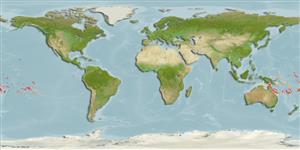Классификация / Names
народные названия | синонимы | Catalog of Fishes(род, виды) | ITIS | CoL | WoRMS | Cloffa
>
Blenniiformes (Blennies) >
Blenniidae (Combtooth blennies) > Salariinae
Etymology: Cirripectes: Latin, cirrus = curl fringe + Greek, pektos, -e, -on = made of several parts solidly united (Ref. 45335); jenningsi: Named for Mr. Jennings of Swains Island..
More on author: Schultz.
Environment: milieu / climate zone / depth range / distribution range
экология
морской демерсальный; пределы глубины 0 - 10 m. Tropical; 5°N - 25°S
Pacific Ocean: Gilbert Islands to the Tuamoto Islands.
Length at first maturity / Size / Вес / Возраст
Maturity: Lm ?, range 4 - ? cm
Max length : 7.6 cm SL самец/пол неопределен; (Ref. 529)
Краткое описание
морфология | морфометрия
колючие лучи спинного плавника (общее число): 12 - 13; членистые (мягкие) лучи спинного плавника (общее число): 15-16; колючие лучи анального плавника 2; членистые (мягкие) лучи анального плавника: 15 - 17; позвонки: 31 - 32. Diagnosis: Dorsal fin XII, 15, membrane attached to caudal fin, with deep notch above last spine, first spine almost same or slightly higher than second; anal fin II, 16; pectoral rays 15; pelvic fin I, 4; caudal fin procurrent rays 10-14. Vertebrae 10 + 21. LL, without scales and scalelike flaps; LL tubes 2-11 (usually 5-9), canal ends below 15th dorsal ray to caudal-fin base. Upper lip crenulae 41-47. Gill rakers 19-24. Cephalic sensory pore complex. Cirri, supraorbital 2-4, nasal 8-19; nuchal 34-44, row uninterrupted, without nuchal flap, cirri connected at their bases by a membranous ridge. Adults and juveniles anterior body light rose with black spots and 2 broad bars, posteriorly dark purple or blue with white spots, cirri pale. Ophioblennius overall cream with small dark brown spot on posterior of lower lip (in alcohol) (Ref. 529).
Facultative air-breathing in the genus (Ref. 126274); Adults inhabit shallow coral reefs (Ref. 529). Oviparous. Eggs are demersal and adhesive (Ref. 205), and are attached to the substrate via a filamentous, adhesive pad or pedestal (Ref. 94114). Larvae are planktonic, often found in shallow, coastal waters (Ref. 94114).
Oviparous, distinct pairing (Ref. 205). Urogenital orifice of male genital papilla located basally behind a single slender filament on a fleshy swelling behind anus; testes bulbous with length equal to its width (Ref. 529).
Williams, J.T., 1988. Revision and phylogenetic relationships of the blenniid fish genus Cirripectes. Indo-Pac. Fish. (17):78 p. (Ref. 529)
Статус Красного Списка МСОП (Ref. 130435)
Угроза для людей
Harmless
Использование человеком
рыболовство: интереса не представляет
дополнительная информация
Возраст/РазмерыростЗависимость между длиной и массой телаЗависимость между длинамиРазмерный составморфометрияморфологияличинкидинамика численности личинокпополнениечисленностьBRUVS
ссылкиаквакультура (рыбоводство)особенности рыбоводствастепень растяжениягенетикаElectrophoresesнаследуемостьболезниобработкаNutrientsMass conversion
соавторыизображенияStamps, Coins Misc.звукиCiguateraскоростьтип плаванияжаберная областьOtolithsмозгзрение
инструменты
Специальные отчеты
Скачать в формате XML
ресурсы в Интернет
Estimates based on models
Preferred temperature (Ref.
123201): 25.2 - 29.1, mean 27.4 °C (based on 304 cells).
Phylogenetic diversity index (Ref.
82804): PD
50 = 0.5000 [Uniqueness, from 0.5 = low to 2.0 = high].
Bayesian length-weight: a=0.01072 (0.00480 - 0.02393), b=3.01 (2.82 - 3.20), in cm total length, based on LWR estimates for this (Sub)family-body shape (Ref.
93245).
Trophic level (Ref.
69278): 2.0 ±0.00 se; based on food items.
устойчивость к внешним воздействиям (Ref.
120179): высокий, минимальное время удвоения популяции до 15 месяцев (Preliminary K or Fecundity.).
Fishing Vulnerability (Ref.
59153): Low vulnerability (10 of 100).
